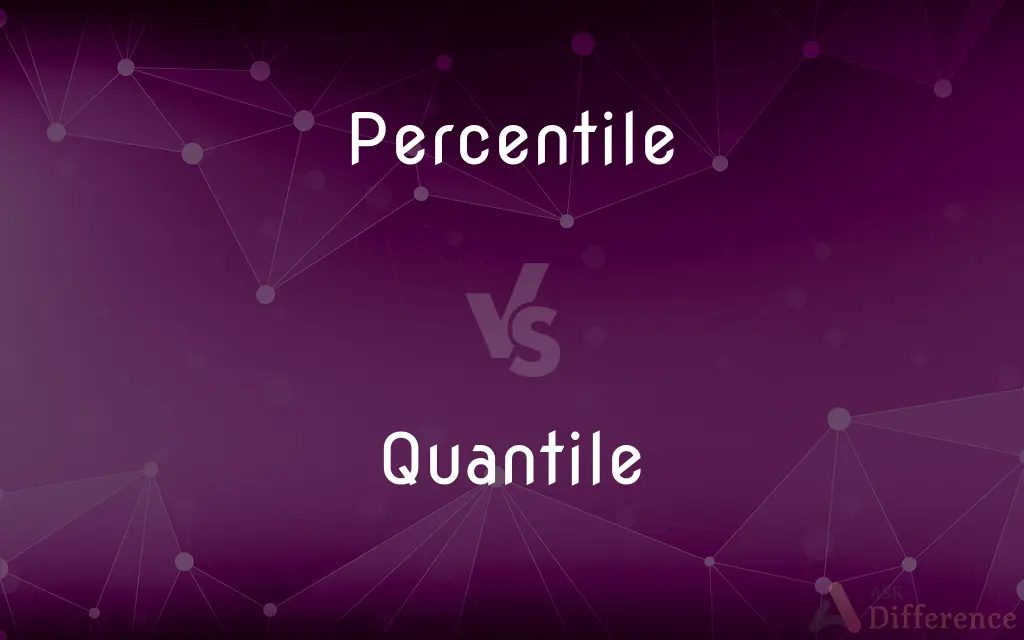Percentile vs. Quantile — What's the Difference?
By Urooj Arif & Fiza Rafique — Updated on March 11, 2024
Percentiles divide a dataset into 100 equal parts, highlighting the distribution's position, while quantiles are more general, dividing data into equal-sized subsets, such as quartiles or deciles.

Difference Between Percentile and Quantile
Table of Contents
ADVERTISEMENT
Key Differences
Percentiles are specific types of quantiles that split a dataset into 100 equal parts, making it easier to understand where a value stands in comparison to others in the dataset. Quantiles, on the other hand, refer to any division of the data into equal-sized segments, not limited to 100 parts, which can include quartiles, deciles, or any other partition.
When discussing the 50th percentile, it refers to the value below which 50% of the data falls, commonly known as the median. Whereas in quantiles, the median is a specific case, often referred to as the 2-quantile, dividing the dataset into two equal halves.
Percentiles are widely used in educational assessments and health metrics to compare individual scores or measurements against a broader population. Quantiles, while also used for comparison, offer a more flexible approach to data analysis, allowing for divisions that are more relevant to the specific context or discipline.
Calculating a percentile involves ranking the data, then finding the place that corresponds to the desired percentile (e.g., the 25th percentile). Quantile calculations follow a similar process but are adjusted based on the number of divisions desired (e.g., dividing data into quartiles or deciles).
The use of percentiles is particularly common in settings where a fine-grained comparison is necessary, such as standardized test scores where distinguishing between closely ranked individuals is important. Quantiles are more commonly used in statistical analyses to describe the distribution of data, highlight trends, and identify outliers.
ADVERTISEMENT
Comparison Chart
Definition
Divides data into 100 equal parts
Divides data into equal-sized subsets
Specific Types
N/A (percentiles are a type of quantile)
Quartiles, deciles, percentiles
Use Cases
Educational assessments, health metrics
Statistical analysis, data distribution description
Calculation
Rank data, find value at specific percent
Rank data, divide into desired number of segments
Example
90th percentile shows the value below which 90% of data falls
Median is a 2-quantile, dividing data into halves
Compare with Definitions
Percentile
A measure indicating the value below which a given percentage of observations in a group of observations falls.
Her test score was in the 85th percentile, meaning she scored better than 85% of the participants.
Quantile
A generic term for dividing a probability distribution into equal-sized, continuous intervals.
The first quartile represents the 25th quantile of the data.
Percentile
Helps in understanding distributions of scores or measurements.
The 50th percentile, or median, divides the dataset into two equal halves.
Quantile
Includes specific cases like quartiles, deciles, percentiles.
The third decile is a type of quantile that divides the data into ten parts.
Percentile
Reflects relative standing within a dataset.
Your performance falls into the 70th percentile, indicating above-average results.
Quantile
Can be tailored to the needs of the analysis.
Choosing the right quantile division can reveal hidden patterns in the data.
Percentile
Used to compare and rank individuals in a population.
He is in the 95th percentile for height, making him taller than most of his peers.
Quantile
Helps in identifying outliers and data trends.
Observing data across different quantiles helps pinpoint unusual values.
Percentile
Applies to standardized testing and measurements.
The percentile ranks for this exam will determine scholarship eligibility.
Quantile
Useful in statistical analyses to summarize data distributions.
We analyzed the quantiles to identify the distribution's skewness.
Percentile
In statistics, a percentile (or a centile) is a score below which a given percentage of scores in its frequency distribution falls (exclusive definition) or a score at or below which a given percentage falls (inclusive definition). For example, the 50th percentile (the median) is the score below which (exclusive) or at or below which (inclusive) 50% of the scores in the distribution may be found.
Quantile
In statistics and probability, quantiles are cut points dividing the range of a probability distribution into continuous intervals with equal probabilities, or dividing the observations in a sample in the same way. There is one fewer quantile than the number of groups created.
Percentile
Each of the 100 equal groups into which a population can be divided according to the distribution of values of a particular variable.
Quantile
Each of any set of values of a variate which divide a frequency distribution into equal groups, each containing the same fraction of the total population.
Percentile
Any of the groups that result when a frequency distribution is divided into 100 groups of equal size.
Quantile
(statistics) One of the class of values of a variate which divides the members of a batch or sample into equal-sized subgroups of adjacent values or a probability distribution into distributions of equal probability.
Percentile
Any of the values that separate each of these groups.
Percentile
(statistics) Any of the ninety-nine points that divide an ordered distribution into one hundred parts, each containing one per cent of the population.
Percentile
(statistics) Any one of the hundred groups so divided.
He is highly intelligent – he has an IQ in the top percentile.
Percentile
(statistics) any of the 99 numbered points that divide an ordered set of scores into 100 parts each of which contains one-hundredth of the total
Common Curiosities
What exactly distinguishes a percentile from a quantile?
A percentile is a specific type of quantile that divides the dataset into 100 equal parts, focusing on detailed ranking within the data.
Can percentiles provide the same insights as quartiles?
Percentiles can provide more granular insights compared to quartiles, which divide data into four parts, by offering a finer comparison across the dataset.
Can percentiles help in identifying data skewness?
While percentiles mainly rank and compare individual scores, significant differences between percentiles (e.g., between the 25th and 75th) can hint at data skewness.
How are quantiles used in data analysis?
Quantiles, including quartiles and percentiles, are used to describe the distribution, identify outliers, and understand trends within a dataset.
Why are quantiles important in statistical modeling?
Quantiles are crucial in statistical modeling for assessing the probability distribution of data, evaluating model performance across different parts of the data distribution, and managing outliers.
Is the median a percentile or a quantile?
The median is both a percentile (the 50th percentile) and a quantile (specifically, a 2-quantile), representing the middle value of a dataset.
How do percentiles relate to standardized test scores?
Percentiles in standardized test scores show how a test taker's score compares to others, indicating the percentage of people the test taker scored better than.
Are quartiles considered a type of quantile?
Yes, quartiles are a specific type of quantile that divide the dataset into four equal parts, each representing a key distribution point (25th, 50th, 75th percentiles).
Why might a researcher choose to use quantiles over percentiles?
A researcher might choose quantiles for flexibility in analysis, allowing for data division that's more suited to the specific context or research question.
How does the choice between percentiles and quantiles affect data analysis outcomes?
The choice impacts the granularity of analysis; percentiles provide more detailed ranking information, while quantiles offer broader data segmentation, affecting insights into distribution and variance.
Share Your Discovery

Previous Comparison
Broom vs. Vroom
Next Comparison
Perspective vs. InsightAuthor Spotlight
Written by
Urooj ArifUrooj is a skilled content writer at Ask Difference, known for her exceptional ability to simplify complex topics into engaging and informative content. With a passion for research and a flair for clear, concise writing, she consistently delivers articles that resonate with our diverse audience.
Co-written by
Fiza RafiqueFiza Rafique is a skilled content writer at AskDifference.com, where she meticulously refines and enhances written pieces. Drawing from her vast editorial expertise, Fiza ensures clarity, accuracy, and precision in every article. Passionate about language, she continually seeks to elevate the quality of content for readers worldwide.














































